-
This article tells you about the teachings of Srimanta Sankaradeva and Raas Mahotsav ie celebrated in Majuli every year.
Do you know the name of India’s first island district and amongst the largest inhabited river islands worldwide?
Majuli
was formed due to the course changed by the Brahmaputra and its tributaries,
mainly the Lohit. On the north bank is the river Subansiri and on the south
bank, the Brahmaputra. It had an area of 1250 sq kms originally. Due to erosion
etc. area sq. kms has fallen to about 650 today.
To
reach Majuli travel to Jorhat i.e. connected to Guwahati by train and direct
flights from Kolkata. Drive to Nimatighat and take a ferry to Majuli. The one
hour ride is enjoyable, the newly introduced RO RO ferry making it safer.
Since Srimanta Sankaradeva and Assam are synonymous the article is
about his teachings. Part two of article has ideas to promote tourism to
Majuli.
What is special about Majuli?
It is the cradle of the Assamese civilization for more than 550 years. It is here that Assam’s great saint, poet, social reformer ‘Srimanta Sankaradeva’ and his famous disciple Madhabdeva lived in the 16th century. Ever since
they established Satras
(monasteries), Majuli has become the centre of Vaishavite Culture of Assam. Here Vaishavism intermingles with tribal
ethos.
Due
to Srimanta Sankaradeva, Madhabdeva and
the sukarmas of Satra bhakats (monks), Majuli is an oasis of peace and tranquillity. The island’s cultural traditions, rivulets, streams, vegetation, biodiversity, Satras, masks and hand pot making skills, friendly people and Raas Mahotsav
make it worthy of a visit.
Who was Srimanta Sankaradeva?
Sankaradeva
was born in 1449 and died in 1569 A.D. A multifaceted personality, he was an
artist, painter, lyricist, social reformer, dancer, sculptor, playwright,
composer, philosopher, Sanskrit scholar and a yogi.
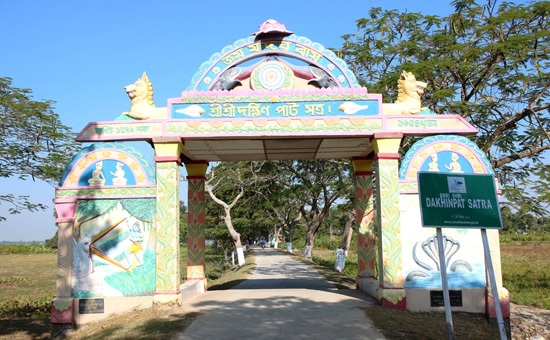 Entrance to 17th
century Dakhinpat Satra-Monastery
Entrance to 17th
century Dakhinpat Satra-Monastery
What were Sankaradeva’s beliefs?
Sankaradeva ushered in the
Neo-Vaishnavite movement in this part of the country making Bhagawata the
principal medium to serve the people. He used songs, dance, music and bhaona (drama) as a medium through which
the common man was made to understand the essence of bhakti ras (devotion). He thereby established the ‘Ek Saran Naam Dharma’.
The primary basis of Sankaradeva’s philosophy is worshipping a single deity - Absolute Brahma. In order to help in realization of Brahma in Vedanta he made Krishna (in Bhagawata) as the single deity. In order to help understand the aspects of Krishna, he chose Kishna naam (Chanting of Krishna) as its basis. He said that Krishna naam can fulfil the aim of true human beings through Kirtana (chanting). Ref 3 (90)
Following Srimanta Sankaradeva’s footsteps and keeping the four components together – Guru, Dev, Naam, Bhakat the Satra with Naamghar (prayer hall), Manikut (place to keep the asana), Hati (dwelling place for inmates and Bharalghar (treasure house) evolved with time. The aim of dwellers in satra is to lead people towards Bhagawata. Ref 3 (32)
.jpg) Sri Krishna in room of Sattradhikar of Garhmur Satra
Sri Krishna in room of Sattradhikar of Garhmur Satra
What is a Satra?
Satra
is a religious monastery, storehouse of art and culture where resides Guru (Sattradhikar (spiritual head), Dev, Naam
(chanting of Krishna’s name) and Bhagat
(devotee).
According to a leading Sattradhikar, Dr Shri Pitamber Deva Goswami, the main objective of a Satra is “to motivate the minds of the people to realize the existence of the Supreme Power through spiritual performance, execution of Sharana-prayer, Nam-Prashanga-religious festivals and the recitation of rhymes and scripture of Shri Krishna”. Ref 2 (10)
There is a regular practice of fourteen “Prashangas” prayers. These prayers are performed thrice a day. Satra affairs are now being looked after by a Managing Committee which in early times was being looked after by the Satra Sabha.
By
bringing out the idea of realizing every human being as an image of Lord Vishnu,
Sankaradeva spread the message of respect to all breaking all social barriers.
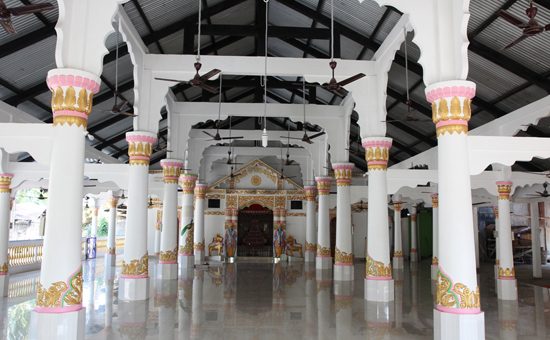 Inside a village Naamghar, Majuli.
Inside a village Naamghar, Majuli.
What is a Naamghar?
Naamghar is the centre
to practice spiritual, moral and artistic knowledge. It consists of a hall where
devotees gather, listening and enchanting of the name of the Bhagawata
(Absolute Soul) and playing musical instruments. Devotees forget their
individual identity to assume the identity of congregational existence. Ref 3 (39)
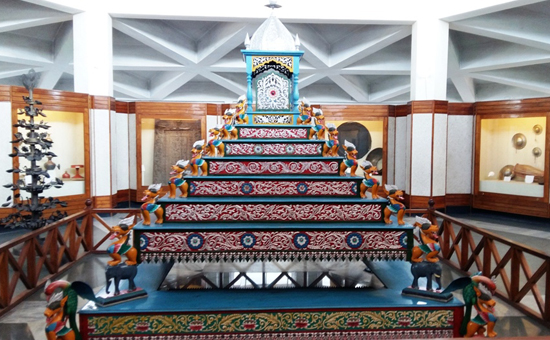 Manikut. Top is Guru Sthan where Bhagawata Purana is kept. Pic at Shankaradeva Kalashetra.
Manikut. Top is Guru Sthan where Bhagawata Purana is kept. Pic at Shankaradeva Kalashetra.
End
of hall is a Manikut (wooden structure). Brahma is placed in the Asana in the
Manikut. On its top is Guru Sthan where the Bhagawata Purana is kept. In some
Satras idols of Krishna are kept in the Guru Sthan.
Sankaradeva
introduced the concept of Gayan-Bayan i.e. combination of Geet (song), Badya
(instrument) and Nritya (dance). He
started the use of bamboo and cane, instead of stone and iron in building
Naamghar, since it was available locally.
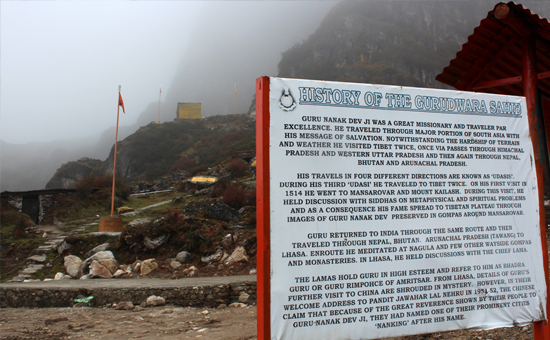 Gurudwara near Tawang, Arunachal Pradesh.
Gurudwara near Tawang, Arunachal Pradesh.
Is Naamghar like a Gurudwara?
The
concept of Naamghar, placing of holy book Bhagawata
on an asana, taking naam (chanting) and lack of idol reminded me of a
Gurudwara.
Around 1515 and when Sankaradeva lived Guru Nanak visited Tibet via Tawang. Was he influenced by Sankaradeva’s teachings? The late Khushwant Singh said that Sikhism is distilled Vedanta whilst what Sankaradeva aimed for is realization of Brahma in Vedanta.
Chandigarh based Author and Kriyacharya Jyoti Subramaniam says, “Just like no man is an island, no existing philosophy can say it was not influenced by the times it originated in. Two similarities strike in the first instance. Chanting Naam Naam Japo (Repeat the Divine Name) being one of the three major directives to Sikhs and belief in the one absolute Akal Purakh Absolute Brahman.”
As
stated earlier Sankaradeva sought the idea of realizing every human being as an
image of Lord Vishnu. According to a SGPC booklet on Golden Temple, its actual name
is Hari Mandir. 4 The name ‘Hari’ is one of the names of Vishnu in the Vishnu Sahasranama.
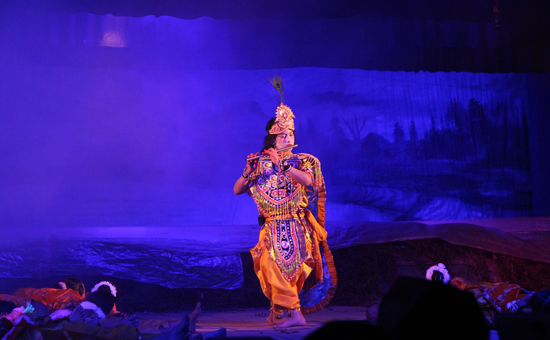 Raas Mahotsav
2018
Raas Mahotsav
2018
What is Raas Mahotvas?
The festival is unique to Majuli. Raas Lila is the story of the life of Lord Krishna presented in the performing art form and as mentioned in the ‘Bhagawata Purana’.
“It is classified mainly into nine Bhakti Raas. It starts with the birth of Krishna, his upbringing at the house of king Nanda, his tending the cows at Gokula along with his fellow cowherds, his childhood activities, his killing of demons like Bakasur, Oghasur etc. and his maternal uncle Kamsa and finally his amorous play with the Gopis. Performance of Raas Lila involves various classes of musical instruments, music and dance, and artefacts, masks and painting.” 1
It
is held on 22-24th November every year. About sixty-five performances
are held simultaneously in Sattras and villages.
Performances
start about 8.30 pm and go on till wee hours of the morning. Every Satra
presents the same story creatively. Acting, dialogue delivery and sound effects
are awesome. This author does not understand Assamese but if one knows the gist
of the story can relate easily. Saw many tourists, from India and abroad,
enjoying as well.
The
first Raas Leela was performed at Dakshinpat Sattra in 1840 AD and has
continued since then. In 1950 Pitambardeva Goswami ex Sattradhikar and social
reformer permitted girls of the Sattra to take roles in the Raas Lila and
dance. Today it is a norm in most monasteries although in the Udasin
monasteries men play the role of women.
To truly understand Sankaradeva’s teachings one must visit Majuli. Because of Srimanta Sankaradeva’ and disciple Madhabdeva presence Majuli is very peaceful and tranquil.
Majuli
awaits you!
The
author has taken utmost care whilst writing the above and got it reviewed by an
Assamese scholar too. In case you find any errors please write in.
Author is founder www.esamskriti.com
and a travel photojournalist.
References
1
Raas Mahotsav 2018 by Directorate of Tourism Assam.
2 Majuli – The Paradise of Sattriya Culture by Keshab Kakati
3
The Blazing Talent Srimanta Sankaradeva by Dr Pitamber Dev Goswami
4 The Golden Temple published by Shiromani Gurudwara Parbandhak Committee, Amritsar.
Also
read
1
Spiritual
Teachings of Srimanta Sankaradeva
2
Culture – A Tribute to Sankaradeva
3
Literature – A Tribute to Sanakaradeva
4
Srimanta
Sankaradev Museum in Guwahati
5
To buy book on
Srimanta Sankaradeva by Bimal Phukan
6 Pics Temples of Guwahati different design and forms of worship
7 Pics Temples of Sivasagar different design and forms of worship